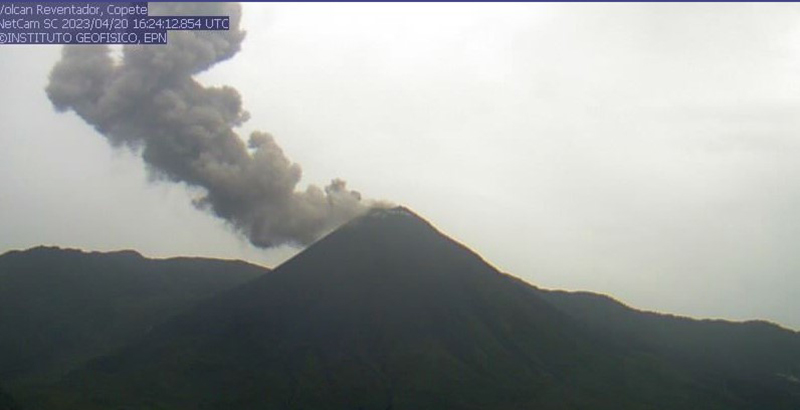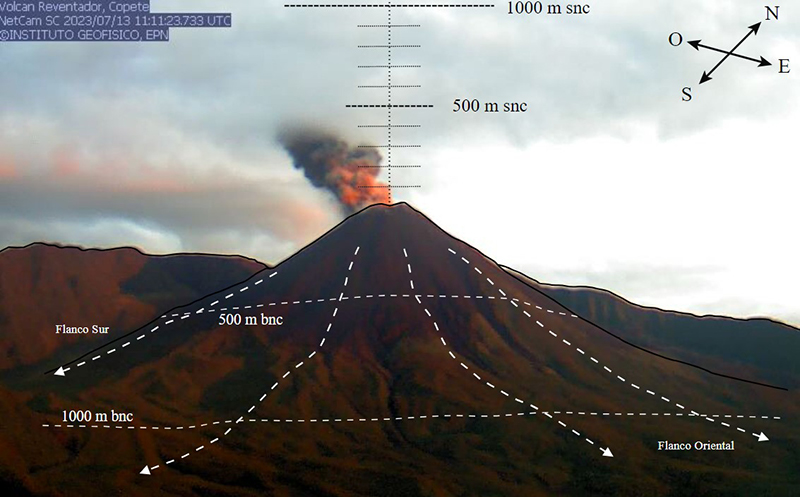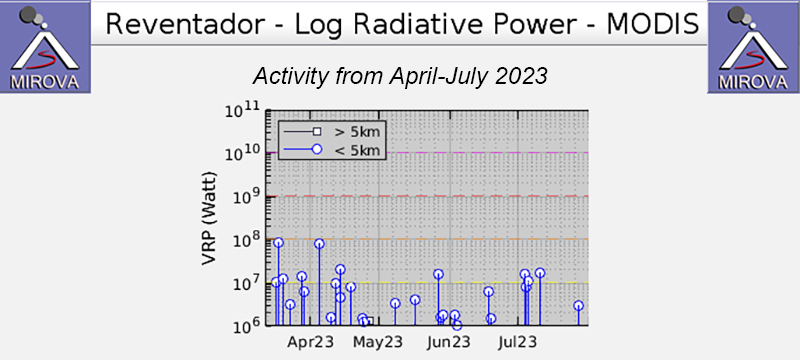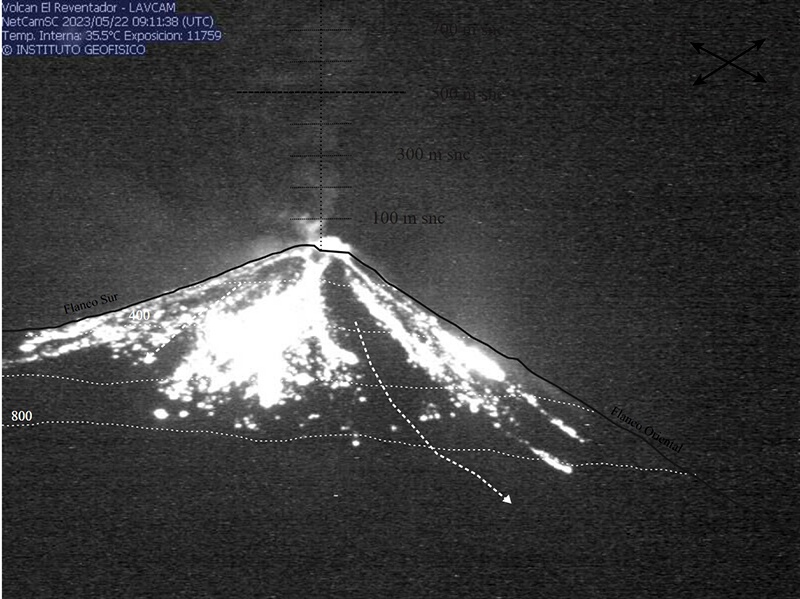Report on Reventador (Ecuador) — August 2023
Bulletin of the Global Volcanism Network, vol. 48, no. 8 (August 2023)
Managing Editor: Benjamin Andrews.
Edited by Kadie L. Bennis.
Reventador (Ecuador) Daily explosions, gas-and-ash emissions, and block avalanches persisted during April-July 2023
Please cite this report as:
Global Volcanism Program, 2023. Report on Reventador (Ecuador) (Bennis, K.L., and Andrews, B., eds.). Bulletin of the Global Volcanism Network, 48:8. Smithsonian Institution.
Reventador
Ecuador
0.077°S, 77.656°W; summit elev. 3562 m
All times are local (unless otherwise noted)
Volcán El Reventador, located in Ecuador, is a stratovolcano with a 4-km-wide avalanche scarp open to the E that was formed by edifice collapse. The largest recorded eruption took place in 2002, producing a 17-km-high eruption column, pyroclastic flows that traveled up to 8 km, and lava flows from summit and flank vents. Recorded eruptions date back to the 16th century and have been characterized by explosive events, lava flows, ash plumes, and lahars. Frequent lahars in this region of heavy rainfall have built deposits on the scarp slope. The current eruption period began in July 2008 and has recently been characterized by daily explosions, gas-and-ash emissions, crater incandescence, and block avalanches (BGVN 48:04). This report updates similar activity during April through July 2023 using daily reports from Ecuador's Instituto Geofisico (IG-EPN), the Washington Volcano Ash Advisory Center (VAAC), and satellite data.
During April through July 2023, IG-EPN reported daily explosions, gas-and-ash plumes rising as high as 3 km above the crater, and frequent nighttime crater incandescence, often accompanied by incandescent block avalanches that affected one or multiple flanks. On average, there were more daily explosions detected during May 2023, with an average total of 39 per day (table 18).
Table 18. Monthly summary of explosions and plume heights recorded at Reventador from April through July 2023. Data courtesy of IG-EPN (April-July 2023 daily reports) and the Washington VAAC.
| Month | Average number of explosions per day | Max plume height above the crater rim (km) |
| Apr 2023 | 29 | 1.6 |
| May 2023 | 39 | 3 |
| Jun 2023 | 20 | 2 |
| Jul 2023 | 31 | 1.2 |
Activity during April 2023 consisted of 18-42 daily explosions that ejected material and nighttime crater incandescence, though weather clouds often prevented clear views of the summit. Frequent seismicity was mainly characterized by long-period (LP) events and tremor associated with emissions (TREMI). Intermittent gas-and-ash emissions rose 500-1,500 m above the summit and drifted N, NW, W, SW, and NE, based on webcam images and satellite imagery (figure 175). The Washington VAAC also reported frequent ash emissions that rose 700-1,600 m above the crater and drifted E, NW, SE, NE, N, and W. During 31 March to 1 April nighttime crater incandescence was observed and ejected material landed 400 m below the crater on the E flank. Incandescent blocks were visible rolling on each of the flanks as far as 500 m below the crater during 4-5 April. During 9-16 April incandescent blocks were visible affecting one or multiple flanks, traveling as far as 500-700 m below the crater rim. A small pyroclastic flow deposit was reported on the SE flank during 10-11 April. During the night and early morning of 14-15 April several explosions were observed, accompanied by incandescent blocks descending all the flanks as far as 700 m below the crater. IG-EPN reported that the REVN station stopped working due to technical problems, so event data was not recorded during 18 April through 3 May. According to GOES-16 satellite images, ash emissions rose less than 1.5 km above the crater and drifted SE, which caused light ashfall in Gonzalo Díaz de Pinea (El Chaco, 35 km SE) on 18 April.
 |
Figure 175. Webcam image of a gas-and-ash plume rising above Reventador on 20 April 2023. Courtesy of IG-EPN (INFORME DIARIO DEL VOLCAN REVENTADOR No. 2023-111, 21 de abril de 2023). |
Gas-and-ash emissions and seismicity characterized by frequent LP- and TREMI-type events continued during May. Near-daily explosions ranged from 21-68 per day, sometimes accompanied by incandescent block avalanches, which affected one or multiple flanks and traveled 500-1,000 m below the crater rim (figure 176). Frequent gas-and-ash emissions rose 250-3,000 m above the crater and drifted in multiple directions, according to webcam and satellite imagery; the highest gas-and-ash plume rose 3 km above the crater during the morning of 23 May and drifted W and NW. Several explosions were observed in webcam images; resulting ash plumes rose 500-1,000 m above the crater and drifted W during 5-6 May. Nighttime crater incandescence was visible almost every night on clear weather days. According to the Washington VAAC, frequent ash emissions rose 400-1,300 m above the crater and drifted W, NW, N, and NE. At 1957 on 12 May webcam images showed incandescent material traveling 200 m below the crater rim. The REVS seismic station recorded a high-frequency signal possibly associated with mudflows at 1000 on 18 May. During the morning of 28 May IG-EPN reported a lahar toward the E, though no damage was noted.
Daily explosions and ash plumes continued during June, with 7-45 explosions recorded each day. LP and TREMI-type events and crater incandescence were also frequently recorded on clear weather days, cloudy weather often obscured views of the summit. Gas-and-ash emissions rose 200-1,000 m above the summit and drifted W, NW, SW, and NE (figure 177). Nighttime crater incandescence persisted, accompanied by block avalanches that traveled 400-800 m below the summit affecting one or multiple flanks. The Washington VAAC reported that ash emissions rose 700-2,000 m above the crater and drifted NW and W. During the night of 21 June crater incandescence was reported, as well as a lava flow that descended the S flank. The flow continued into the morning of 22 June.
 |
Figure 177. Webcam image of a gas-and-ash plume rising above Reventador on 12 June 2023. Courtesy of IG-EPN (INFORME DIARIO DEL VOLCAN REVENTADOR No. 2023-163, 12 de junio de 2023). |
Daily explosions, LP- and TREMI-type events, crater incandescence, and block avalanches continued during July. There were 16-59 daily explosions detected throughout the month. Gas-and-ash emissions rose 200-1,200 m above the crater and drifted in different directions (figure 178). Nighttime crater incandescence continued, with frequent block avalanches affecting all the flanks and descending 400-800 m below the crater rim. The Washington VAAC reported that intermittent ash emissions rose 700-1,000 m above the summit and drifted W and NW. On 7 July at approximately 1100 the REVS and REVN seismic stations recorded high-frequency signals that corresponded to lahars descending the drainage system.
 |
Figure 178. Webcam image of a gray gas-and-ash plume rising above Reventador on 13 July 2023. Courtesy of IG-EPN (INFORME DIARIO DEL VOLCAN REVENTADOR No. 2023-194, 13 de julio de 2023). |
Additional satellite data. MIROVA (Middle InfraRed Observation of Volcanic Activity) analysis of MODIS satellite data showed intermittent thermal anomalies of low-to-moderate power (figure 179). The MODVOLC hotspot system identified a total of six hotspots on 5 April (3), 14 April (2), and 4 July (1). Though the summit was often obscured by weather clouds, an infrared satellite image taken on 11 April showed a strong thermal anomaly.
 |
Figure 179. Intermittent low-to-moderate strength thermal activity was detected at Reventador during April through July 2023, based on this MIROVA graph (Log Radiative Power). Courtesy of MIROVA. |
Geological Summary. Volcán El Reventador is the most frequently active of a chain of Ecuadorian volcanoes in the Cordillera Real, well east of the principal volcanic axis. The forested, dominantly andesitic stratovolcano has 4-km-wide avalanche scarp open to the E formed by edifice collapse. A young, unvegetated, cone rises from the amphitheater floor to a height comparable to the rim. It has been the source of numerous lava flows as well as explosive eruptions visible from Quito, about 90 km ESE. Frequent lahars in this region of heavy rainfall have left extensive deposits on the scarp slope. The largest recorded eruption took place in 2002, producing a 17-km-high eruption column, pyroclastic flows that traveled up to 8 km, and lava flows from summit and flank vents.
Information Contacts: Instituto Geofísico, Escuela Politécnica Nacional (IG-EPN), Casilla 17-01-2759, Quito, Ecuador (URL: http://www.igepn.edu.ec/); MIROVA (Middle InfraRed Observation of Volcanic Activity), a collaborative project between the Universities of Turin and Florence (Italy) supported by the Centre for Volcanic Risk of the Italian Civil Protection Department (URL: http://www.mirovaweb.it/); Hawai'i Institute of Geophysics and Planetology (HIGP) - MODVOLC Thermal Alerts System, School of Ocean and Earth Science and Technology (SOEST), Univ. of Hawai'i, 2525 Correa Road, Honolulu, HI 96822, USA (URL: http://modis.higp.hawaii.edu/); Copernicus Data Space Ecosystem, European Space Agency (URL: https://dataspace.copernicus.eu/browser/).


